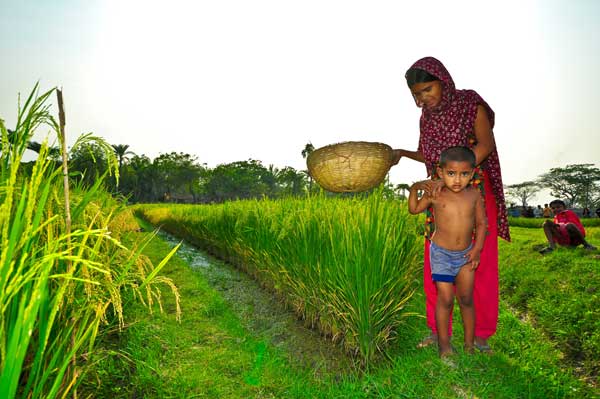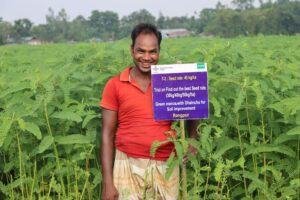
Rice is a staple for the majority of the 1.7 billion South Asian population and a source of livelihood for more than 50 million households. Apart from its economic and strategic importance, rice is deeply engraved in the rich tradition and culture of many South Asian countries. In India and Nepal, rice offerings to bring good health and prosperity to family members are common on many auspicious occasions. The significance of rice extends beyond life for Hindu communities in the region with offerings given to the departed soul. Similarly, in Sri Lanka, during the marriage ceremony, known as Poruwa, the bride and groom are placed on the top of paddy to bring fertility to the couple. One can find many religious and cultural uses of rice or paddy throughout South Asia.
The region cultivates rice on 60 million hectares and produces slightly above 225 million tons of paddy, accounting for 37.5% of the global area and 32% of global production in 2013.Within South Asia, both India and Bangladesh are major rice-growing countries. India has the largest rice area in the world with 43 million hectares (more than a quarter of the global rice area) and contributes a little less than a quarter of global production. Bangladesh has more than 11 million hectares of rice area and produces 50 million tons of paddy.
The other three rice-growing countries in South Asia—Pakistan, Nepal, and Sri Lanka—together have slightly above 5 million hectares of rice area and produce 17 million tons of paddy. Current paddy production in South Asia is more than 300% more than what it was at the start of the Green Revolution in the late 1960s. The majority of this production increase in the past five decades has come from yield growth, with harvested area growing by only 20% from 50 million hectares in the late 1960s to 60 million hectares now.

During this period, production has been able to keep up with population growth, with a steady increase in per capita production between the mid-1970s and mid-‘90s by more than 10 kilograms, before flattening out and then starting to rise again in the past few years (Fig. 1). An overlay of per capita consumption on per capita production reveals that consumption followed the upward trend in production until the early ‘90s. But, after that, per capita consumption declined for a few years and then stabilized at 80–82 kilograms in the past 15 years—making South Asia a growing exporter of rice.
South Asian rice exports increased from 2 million tons in the early 1990s to 14 million tons in 2013 (Fig. 2). Apart from India, the largest exporter of rice in the world, Pakistan’s rice exports have been steadily rising for the past three decades, reaching 4 million tons in recent years. On the import side, two South Asian countries, Bangladesh and Nepal, import a small amount of rice, 1–2 million tons annually. In the past few years, imports have fallen below 1 million tons primarily because of favorable weather in the region.

Despite some impressive production growth in the past five decades and the growing status as one of the largest rice-exporting regions in the world, South Asia was still home to 295 million undernourished and hungry people in 2011-13—nearly 35% of the 842 million hungry people in the world. In 2011-13, 16.8% of the people in South Asia were hungry. This is the highest percentage among other Asian regions and is second highest behind Africa, but this is much lower than the 25% hungry people South Asia had in 1990-92.
Future food security challenges
As we move forward, the South Asian population is projected to surpass 2 billion by 2030, or 300 million additional mouths to feed, in the next 15 years. But the good news is that, as income rises, more and more people are likely to diversify their food basket from rice to more high-value products such as fruits and vegetables, meat, and milk and dairy products. In other words, per capita rice consumption, which has been flat for the past 15 years, may decline in the future with the rise in income and urbanization. Since most of the South Asian population is vegetarian, the rate of diversification is likely to be much slower than what has been witnessed in other parts of Asia. In addition, the diversification rate in many South Asian countries may be slowed down because of government interventions with price controls and subsidized food grain distribution.
India is a good example where the government has rolled out an elaborate food subsidy program to provide highly subsidized food grains (rice and wheat) for 65 million below-poverty-line households, including nearly free food grains to 20 million Antyodaya Anna Yojana households, the poorest of the poor households. Each of the 65 million households receives 35 kilograms of grain every month at 74–86% below the procurement cost.
Assuming that per capita consumption remains flat in the next 15 years, then total consumption will grow at the present population growth rate of 1.3% and eventually will fall below 1% by 2030 as population growth slows down. However, if South Asian countries follow a rapid diversification path, total consumption could flatten out by 2030.

On the supply front, it does not sound alarming that South Asia needs to match its production growth with the slowing population growth for future food security. Given that rice area will not further expand in the region, achieving a yield growth of 1% to 1.3% sounds reasonable. But, there are many glaring uncertainties such as growing water shortages, imbalanced fertilization, competition for rice land from nonagricultural uses and biofuel crops, increasing frequency of extreme weather, and emerging pest outbreaks due to climate change that can make things even more challenging. Rapid depletion of groundwater in parts of India and Bangladesh is of serious concern for future productivity growth. In Bangladesh, the boro rice crop (dry-season crop, which largely depends on irrigation) now accounts for 40% of the total area (4.75 million hectares out of a total area of 11.65 million hectares) and contributes 55% of the total paddy production of around 51 million tons. According to the 2013 Bangladesh Grain and Feed Annual published by USDA, the water table in certain parts of Bangladesh is dropping by 4 to 5 feet (1.2 x 1.5 meters) per year because of the expansion of irrigation. The extent of groundwater use can be gauged by the exponential rise in the number of shallow tube wells from 21 in 1980 to about 1.62 million in 2012 (Fig. 3). Similar to Bangladesh, many rice-growing states in India (such as Punjab, Haryana, Uttar Pradesh, and Andhra Pradesh) are facing declining water tables because of intensive ricewheat and rice-rice cultivation.
Imbalanced fertilizer use in favor of nitrogen, due to subsidy and ignorance of farmers on the benefits of balanced fertilizer application, is adversely affecting soil health and is a major concern for future productivity growth in South Asia. Things have improved in India over the years in terms of the imbalance in fertilizer application from an NPK use ratio of 7.9:0.9:1 in 1951 to 4.3:2:1 in 2010, which is closer to the recommended ratio of 4:2:1, according to the report. However, in Bangladesh, things have moved in the opposite direction, with the share of urea in total fertilizer rising from 64% in 1981 to 89% in 2010.
A combination of appropriate policy reforms, the development and dissemination of climate-resilient and resource-conserving technologies such as stress-tolerant or “climate-smart” rice varieties (tolerant of flood, drought, and salinity), and improved production practices including site-specific nutrient management, alternate wetting and drying, and direct-seeded rice can ensure South Asia’s sustainable food security in the future.
A major overhaul of policies is long overdue in the region, which still uses price support for farmers, procurement and redistribution of grains, and border policies to control the flow of rice in and out of the country. These policies that are directed toward reducing market risk played a crucial role in expanding rice production in the past five decades and in achieving self-sufficiency in South Asia. However, on the negative side, these policies have been a growing pain to the state exchequer. For example, the Indian fertilizer subsidy bill increased from less than US$6 billion in 2006-07 to close to $12 billion in 2011-12. The fertilizer subsidy in Bangladesh skyrocketed in recent years because of high international prices, from 3,895.7 crore taka ($569 million) in 2007-08 to 11,456.7 crore taka ($1.47 billion) in 2011-12. This represents more than a 150% rise in 4 years since making a comeback in 2006 (Jahangir Elam presentation on the fertilizer sector in Bangladesh).
The collapse of the Thai mortgage scheme is a good example of how market-distorting programs cannot be sustainable in terms of rising cost over time. Apart from rising cost, these policies have led to excessive and/or imbalanced use of many inputs such as water, fertilizer, and pesticide.
The 21st century policies should aim at supporting farmers without causing much market distortion, and encourage the efficient use of water, fertilizer, and pesticide, among other inputs. Government policies should also be directed toward providing incentives for the rapid adoption of resource-conserving technologies and climate-smart varieties to overcome the negative effects of climate change and improve the sustainability of rice production systems.
_________________________________________
Dr. Mohanty is the head of the Social Sciences Division and program leader (Targeting and policy) at IRRI.









